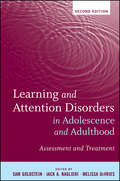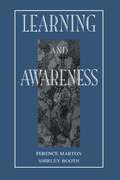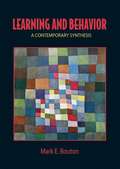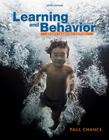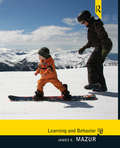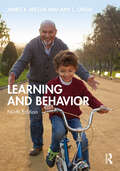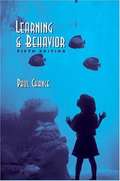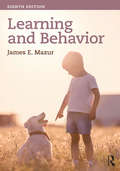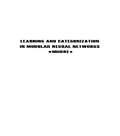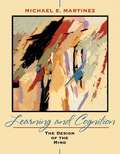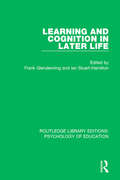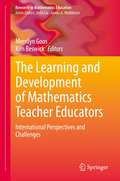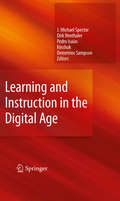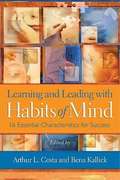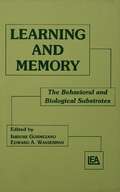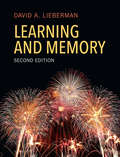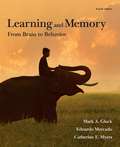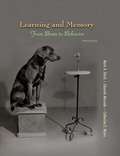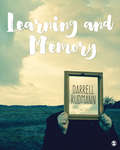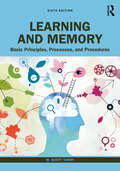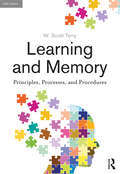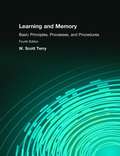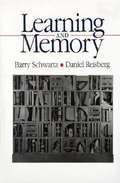- Table View
- List View
Learning and Attention Disorders in Adolescence and Adulthood
by Sam Goldstein Jack A. Naglieri Melissa DevriesFully revised coverage with the most current diagnoses and treatments for adolescents and adults living with learning and attention disordersReflecting the most recent and relevant findings regarding Learning Disabilities (LD) and Attention-Deficit/Hyperactivity Disorder (ADHD), this Second Edition of Learning and Attention Disorders in Adolescence and Adulthood provides practitioners in the fields of education and mental health with a set of practical guidelines to assist in the assessment, diagnosis, consultation, and treatment of adolescents and adults struggling with LD and ADHD. The new edition includes: An emphasis on working from strengths-adapting to disabilities and dealing with them successfully on a daily basis New coverage of the causes and long-term implications of LD and ADHD in adolescents and adulthood New chapters on treatment effectiveness; building resiliency and shaping mindsets; cognitive therapy; and strategic life coaching to help guide individuals with LD and ADHD Contributions from leading researchers, including Noel Gregg, Russell Barkley, Kevin Antshel, and Nancy MatherDrawing on evidence-based techniques to meet the pragmatic demands for intervention, the Second Edition guides school psychologists, counselors, and educators in promoting positive change for adolescents and adults with LD and ADHD as they strive for success in school, work, and home settings.
Learning and Awareness (Educational Psychology Series)
by Ference Marton Shirley BoothThis book stems from more than 25 years of systematic research into the experience of learning undertaken by a research team trying to account for the obvious differences between more or less successful instances of learning in educational institutions. The book offers an answer in terms of the discovery of critical differences in the structure of the learner's awareness and critical differences in the meaning of the learner's world. The authors offer a detailed account of the empirical findings that give rise to theoretical insights, and discuss the particular form of qualitative research that has been employed and developed. The form of learning that is the object of study is considered to be the most fundamental form -- namely a change in the learner's way of seeing, experiencing, handling, and understanding aspects of the world. The need for rigorous analysis of learning of specific subject matter, the individual construction of knowledge, and its social and cultural embeddedness -- the defining features of rival approaches into research on learning -- are reconciled from the approach adopted here into an intertwined and whole experience of learning. The learner's experience is always one of learning something, in some way, and in some context; by holding the learner's experience of learning as the focus of study throughout -- and not studying the learning of the content and the acts and the context as separate and distinct focuses -- the content, the act, and the context remain united as constituents of the learner's experience. By empirically revealing critical differences in the ways of experiencing these aspects of learning, and by developing a theoretical framework for the dynamics through which change comes about in the learner's awareness, this book gradually leads the reader to a powerful new view of learning. Equipped with the analytical tools and conceptual apparatus to be found in this book, the reader will be empowered to learn and to assist others to learn by creating environments conducive to the most fundamental form of learning: experiencing aspects of the world in new ways.
Learning And Behavior: A Contemporary Synthesis
by Mark E. BoutonProviding a strong background in modern learning and behavior theory, this book reflects the importance of the study of animal learning in psychology. Topics covered include learning and adaptation, modern conditioning theories, memory retrieval, instrumental learning, avoidance learning and learned helplessness.
Learning and Behavior: Active Learning Edition (6th edition)
by Paul ChanceThis undergraduate textbook introduces the natural science approach to behavior and describes the efforts of researchers to understand the kinds of experiences that produce learning, the circumstances under which learning in one situation carries over to another situation, the effects of different reinforcement schedules, the durability of learned behavior, and the limitations of learning.
Learning and Behavior: Seventh Edition
by James E. MazurThis book reviews how people and animals learn and how their behaviors are later changed as a result of this learning. Nearly all of our behaviors are influenced by prior learning experiences in some way. This book describes some of the most important principles, theories, controversies, and experiments that pertain to learning and behavior that are applicable to many different species and many different learning situations. Many real-world examples and analogies make the concepts and theories more concrete and relevant to the students. In addition, most of the chapters include sections that describe how the theories and principles have been used in the applied field of behavior modification. Each chapter in the seventh edition was updated with new studies and new references that reflect recent developments in the field. The book includes a number of learning aids for students, including a list of learning objectives at the beginning of each chapter, practices quizzes and review questions, and a glossary for all important terms. Learning & Behavior covers topics such as classical and operant conditioning, reinforcement schedules, avoidance and punishment, stimulus control, comparative cognition, observational learning, motor skill learning, and choice. Both the classic studies and the most recent developments and trends in the field are explored. Although the behavioral approach is emphasized, many cognitive theories are covered as well along with a chapter on comparative cognition.? Upon completing this book readers will be able to:understand the field of learning and discuss real-world applications of learning principles.
Learning and Behavior
by James E. Mazur Amy L. OdumLearning and Behavior reviews how people and animals learn and how their behaviors are changed because of learning. It describes the most important principles, theories, controversies, and experiments that pertain to learning and behavior that are applicable to diverse species and different learning situations. Both classic studies and recent trends and developments are explored, providing a comprehensive survey of the field. Although the behavioral approach is emphasized, many cognitive theories are covered as well, along with a chapter on comparative cognition. Real-world examples and analogies make the concepts and theories more concrete and relevant to students. In addition, most chapters provide examples of how the principles covered have been employed in applied and clinical behavior analysis. The text proceeds from the simple to the complex. The initial chapters introduce the behavioral, cognitive, and neurophysiological approaches to learning. Later chapters give extensive coverage of classical conditioning and operant conditioning, beginning with basic concepts and findings and moving to theoretical questions and current issues. Other chapters examine the topics of reinforcement schedules, avoidance and punishment, stimulus control and concept learning, observational learning and motor skills, comparative cognition, and choice. Thoroughly updated, each chapter features many new studies and references that reflect recent developments in the field. Learning objectives, bold-faced key terms, practice quizzes, a chapter summary, review questions, and a glossary are included. The text is intended for undergraduate or graduate courses in psychology of learning, (human) learning, introduction to learning, learning processes, animal behavior, (principles of) learning and behavior, conditioning and learning, learning and motivation, experimental analysis of behavior, behaviorism, and behavior analysis.
Learning and Behavior (5th edition)
by Paul ChancePer the author: The theme of this edition is that learning is a biological mechanism that aids survival. My goal was to write a text that would cover the course contents in the theory and research of behavior and learning. This book is an instructional tool, not a reference book.
Learning and Behavior (8th Edition): Eighth Edition
by James E. Mazur<p>This book reviews how people and animals learn and how their behaviors are changed as a result of learning. It describes the most important principles, theories, controversies, and experiments that pertain to learning and behavior that are applicable to diverse species and different learning situations. Both classic studies and recent trends and developments are explored, providing a comprehensive survey of the field. <p>Although the behavioral approach is emphasized, many cognitive theories are covered as well, along with a chapter on comparative cognition. Real-world examples and analogies make the concepts and theories more concrete and relevant to students. In addition, most chapters provide examples of how the principles covered have been applied in behavior modification and therapy. <p>Thoroughly updated, each chapter features many new studies and references that reflect recent developments in the field. Learning objectives, bold-faced key terms, practice quizzes, a chapter summary, review questions, and a glossary are included. <p>The volume is intended for undergraduate or graduate courses in psychology of learning, (human) learning, introduction to learning, learning processes, animal behavior, (principles of) learning and behavior, conditioning and learning, learning and motivation, experimental analysis of behavior, behaviorism, and behavior analysis.</p>
Learning and Categorization in Modular Neural Networks
by Jacob M.J. MurreThis book introduces a new neural network model called CALM, for categorization and learning in neural networks. The author demonstrates how this model can learn the word superiority effect for letter recognition, and discusses a series of studies that simulate experiments in implicit and explicit memory, involving normal and amnesic patients. Pathological, but psychologically accurate, behavior is produced by "lesioning" the arousal system of these models. A concise introduction to genetic algorithms, a new computing method based on the biological metaphor of evolution, and a demonstration on how these algorithms can design network architectures with superior performance are included in this volume. The role of modularity in parallel hardware and software implementations is considered, including transputer networks and a dedicated 400-processor neurocomputer built by the developers of CALM in cooperation with Delft Technical University. Concluding with an evaluation of the psychological and biological plausibility of CALM models, the book offers a general discussion of catastrophic interference, generalization, and representational capacity of modular neural networks. Researchers in cognitive science, neuroscience, computer simulation sciences, parallel computer architectures, and pattern recognition will be interested in this volume, as well as anyone engaged in the study of neural networks, neurocomputers, and neurosimulators.
Learning and Cognition: The Design of the Mind
by Michael E. MartinezWhat is the design of the mind? What does that design imply for education? This comprehensive and engaging introduction to human learning and its applications to education focuses on these vital questions by exploring the theories of knowledge, complex cognition, and human intelligence, presenting a clear and interesting overview of the human mind through multiple theoretical lenses. The author delineates how the mind has a clear design, or architecture, that explains simple acts of memory and complex cognition, to highly creative acts and leaps of scientific or artistic insight. Topics covered throughout the text include: memory, motivation, cognitive development, the brain, and intelligence. Unique to this text, the author has provided an interdisciplinary chapter dedicated to theories of knowledge, extended coverage of expert-novice differences and talent development, and a chapter devoted to intelligence. Readers will appreciate special features like Learning Strategies which cover specific application of the theories to classroom practice, and Interest Magnets which explore fascinating topics such as photographic memory, sleep learning, and Einstein's brain. Written like a narrative, Learning and Cognition: The Design of the Mind will delight its readers' interest and attention as they learn about the theories of human learning and cognition and the improvement of the mind through education.
Learning and Cognition in Later Life (Routledge Library Editions: Psychology of Education)
by Frank Glendenning Ian Stuart-HamiltonOriginally published in 1995, within the previous decade there had been significant developments in our understanding of the learning and motivation, together with the conceptual and cognitive development, of older adults. This understanding had been enhanced by findings from longitudinal studies which were now becoming available. These findings demonstrated the gains that had been made in research. In the past, inappropriately conceived studies have led to the perpetuation of myths and stereotypes about the intellectual development of older people. Special attention is paid in this book to changing perceptions of ageing and intelligence, learning aptitude, memory and intelligence testing. The important topic of ageing and wisdom is also discussed.
The Learning and Development of Mathematics Teacher Educators: International Perspectives and Challenges (Research in Mathematics Education)
by Merrilyn Goos Kim BeswickResearch in mathematics teacher education as a distinctive field of inquiry has grown substantially over the past 10-15 years. Within this field there is emerging interest in how mathematics teacher educators (MTEs) themselves learn and develop. Until recently there were few published studies on this topic, and the processes by which mathematics teacher educators learn, and the forms of knowledge they require for effective practice, had not been systematically investigated. However, researchers in mathematics education are now beginning to investigate the development of MTE expertise and associated issues. This volume draws on the latest research and thinking in this area is therefore timely to stimulate future development and directions. It will survey the emerging field of inquiry in mathematics education, combining the work of established scholars with perspectives of newcomers to the field, with the aim of influencing development of the field, invite cross-cultural comparisons in becoming a mathematics teacher educator by highlighting issues in the development of MTEs in different countries, and examine the roles of both mathematics educators and mathematicians in preparing future teachers of mathematics. The primary audience will be university-based mathematics teacher educators and MTE researchers, and postgraduate research students who are seeking academic careers as MTEs. Additional interest may come from teacher educators in disciplines other than mathematics, and education policy makers responsible for accreditation and quality control of initial teacher education programs.
Learning and Instruction in the Digital Age
by J. Michael SpectorInstruction tailored to the individual student, learning and teaching outside the limits of time and space--ideas that were once considered science fiction are now educational reality, with the prospect of an intelligent Web 3.0 not far distant. Alongside these innovations exists an emerging set of critical-thinking challenges, as Internet users create content and learners (and teachers) take increased responsibility in their work. Learning and Instruction in the Digital Age nimbly balances the technological and pedagogical aspects of these rapid changes, gathering papers from noted researchers on a wealth of topics relating to cognitive approaches to learning and teaching, mental models, online learning, communications, and innovative educational technologies, among them: Cognition and student-centered, Web-based learning, The progression of mental models throughout a course of instruction, Experiencing education with 3D virtual worlds, Expanding educational boundaries through multi-school collaboration, Adapting e-learning to different learning styles, The student blog as reflective diary. With its blend of timely ideas and forward thinking, Learning and Instruction in the Digital Age will enrich the work of researchers in educational psychology, educational technology, and cognitive science.
Learning and Leading With Habits of Mind: 16 Essential Characteristics for Success
by Arthur L. Costa Bena KallickIn Learning and Leading with Habits of Mind, noted educators Arthur L. Costa and Bena Kallick present a comprehensive guide to shaping schools around Habits of Mind. The habits are a repertoire of behaviors that help students and teachers successfully navigate the various challenges and problems they encounter in the classroom and in everyday life. The Habits of Mind include: Persisting, Managing impulsivity, Listening with understanding and empathy, Thinking flexibly, Thinking about thinking (metacognition), Striving for accuracy, Questioning and posing problems, Applying past knowledge to new situations, Thinking and communicating with clarity and precision, Gathering data through all senses, Creating, imagining, innovating, Responding with wonderment and awe, Taking responsible risks, Finding humor, Thinking interdependently, Remaining open to continuous learning.
Learning and Memory: From Brain to Behavior (Second Edition)
by Mark A. Gluck Eduardo Mercado Catherine E. MyersDevelopments in neuroscience have changed the field of learning and memory significantly in the last ten years. This comprehensive introduction to learning and memory covers behavioural processes, brain systems, and clinical perspectives.
Learning and Memory: The Behavioral and Biological Substrates
by Isidore Gormezano Edward A. WassermanThis volume presents the views and findings of behaviorally and biologically oriented investigators invited to participate in The University of Iowa's biennial learning and memory symposium. While chapters vary in their scope and depth of coverage, they are all amply referenced so that researchers, teachers, and students can obtain background information appropriate to their respective needs.
Learning and Memory: An Integrative Approach
by David A. LiebermanThe first text to integrate behavioral and cognitive approaches to learning and memory, this engaging textbook emphasizes human research, reflecting the field's evolution. Learning and Memory also recognizes the vital contribution of animal research, covering all historically important studies. Written in a lively and conversational style, this second edition encourages students to think critically. One example is its exploration of the Rescorla-Wagner model, the most important theory of conditioning, now further streamlined to improve student comprehension. Another is the addition of critical-thinking questions, which encourage students to evaluate their reactions to the material they've read, and relate findings to their own lives. Research includes an emphasis on practical applications such as treatments for phobias, addictions, and autism; the arguments for and against corporal punishment; whether recovered memories and eyewitness testimony should be believed; and effective techniques for studying. The text concludes with an overview of neural networks and deep learning.
Learning and Memory: From Brain To Behavior
by Eduardo Mercado Mark Gluck Catherine MyersWith real-world examples, fascinating applications, and clear explanations, this breakthrough text helps uninitiated students understand the basic ideas and human impact of groundbreaking learning and memory research. Its unique organization into three sections—Behavioral Processes, Brain Substrates, and Clinical Perspectives—allows students to make connections across chapters while giving instructors the flexibility to assign the material that matches the course. The new edition again offers the book’s signature inclusion of human and non-human studies and full-color design and images. You’ll find even more meaningful real-life examples; new coverage of learning and memory research and brain-imaging; an expanded discussion of the role of genetics in producing individual differences; new material on the role of sleep in memory, and more.
Learning and Memory
by Catherine E. Myers Eduardo Mercado Mark A. GluckWith its modular organization, consistent chapter structure, and contemporary perspective, this groundbreaking survey is ideal for courses on learning and memory, and is easily adaptable to courses that focus on either learning or memory. Instructors can assign the chapters they want from four distinctive modules (introduction, learning, memory, and integrative topics), with each chapter addressing behavioral processes, then the underlying neuroscience, then relevant clinical perspectives. The book is further distinguished by its full-color presentation and coverage that includes comparisons between studies of human and nonhuman brains. The new edition offers enhanced pedagogy and more coverage of animal learning.
Learning and Memory
by Darrell S. RudmannLearning and Memory provides students with a clear, balanced, and integrated presentation of major theoretical perspectives foundational to the study of human learning and memory. Author Darrell Rudmann uses an engaging personal writing style appropriate for students with little or no previous background in psychology to discuss topics including the major behaviorism theories of learning, modern cognitive theories of memory, social learning theories, the roles of emotion and motivation in learning, and the well-established neurological underpinnings of these perspectives. A concluding chapter on learning and memory concepts in the real world shows students to how these concepts are applied in various industries, from advertising to education and the media.
Learning and Memory
by Darrell S. RudmannLearning and Memory provides students with a clear, balanced, and integrated presentation of major theoretical perspectives foundational to the study of human learning and memory. Author Darrell Rudmann uses an engaging personal writing style appropriate for students with little or no previous background in psychology to discuss topics including the major behaviorism theories of learning, modern cognitive theories of memory, social learning theories, the roles of emotion and motivation in learning, and the well-established neurological underpinnings of these perspectives. A concluding chapter on learning and memory concepts in the real world shows students to how these concepts are applied in various industries, from advertising to education and the media.
Learning and Memory: Basic Principles, Processes, and Procedures
by W. Scott TerryLearning and Memory provides a balanced review of the core methods and the latest research on animal learning and human memory. Topical coverage ranges from the basic and central processes of learning, including classical and instrumental conditioning and encoding and storage in long-term memory, to topics not traditionally covered, such as spatial learning, motor skills, and implicit memory. The general rules of learning are reviewed along with the exceptions, limitations, and best applications of these rules. Alternative approaches to learning and memory, including cognitive, neuroscientific, functional, and behavioral, are also discussed. Individual differences in age, gender, learning abilities, and social and cultural background are explored throughout the text and presented in a dedicated chapter. The relevance of basic principles is highlighted throughout the text with everyday examples that ignite reader interest in addition to more traditional examples from human and animal laboratory studies. Research examples are drawn from education, neuropsychology, psychiatry, nursing, and ecological (or everyday) memory. Each chapter begins with an outline and concludes with a detailed summary. Applications and extensions are showcased in text boxes as well as in distinct applications sections in every chapter, and review and recapitulation sections are interspersed throughout the chapters.
Learning and Memory: Basic Principles, Processes, and Procedures (Fifth Edition)
by W. Scott Terry<p>This thoroughly updated edition provides a balanced review of the core methods and the latest research on animal learning and human memory. The relevance of basic principles is highlighted throughout via everyday examples to ignite student interest, along with more traditional examples from human and animal laboratory studies. Individual differences in age, gender, learning style, cultural background, or special abilities (such as the math gifted) are highlighted within each chapter to help students see how the principles may be generalized to other subject populations. <p>The basic processes of learning – such as classical and instrumental conditioning and encoding and storage in long-term memory in addition to implicit memory, spatial learning, and remembering in the world outside the laboratory – are reviewed. The general rules of learning are described along with the exceptions, limitations, and best applications of these rules. The relationship between the fields of neuropsychology and learning and memory is stressed throughout. <p>The relevance of this research to other disciplines is reflected in the tone of the writing and is demonstrated through a variety of examples from education, neuropsychology, rehabilitation, psychiatry, nursing and medicine, I/O and consumer psychology, and animal behavior. <p>Each chapter begins with an outline and concludes with a detailed summary. A website for instructors and students accompanies the book. Updated throughout with new research findings and examples the new edition features: <p> <li>A streamlined presentation for today’s busy students. As in the past, the author supports each concept with a research example and real-life application, but the duplicate example or application now appears on the website so instructors can use the additional material to illustrate the concepts in class. <li>Expanded coverage of neuroscience that reflects the current research of the field including aversive conditioning (Ch. 5) and animal working memory (Ch. 8). <li>More examples of research on student learning that use the same variables discussed in the chapter, but applies them in a classroom or student’s study environment. This includes research that applies encoding techniques to student learning, for example: studying: recommendations from experts (Ch. 1); the benefits of testing (Ch. 9); and Joshua Foer’s Moonwalking with Einstein, on his quest to become a memory expert (Ch. 6). <li>More coverage of unconscious learning and knowledge (Ch. 11). <li>Increased coverage of reinforcement and addiction (Ch. 4), causal and language learning (Ch. 6), working memory (WM) and the effects of training on WM, and the comparative evolution of WM in different species (Ch. 8), and genetics and learning (Ch. 12).</li>
Learning and Memory: Basic Principles, Processes, and Procedures (4th Edition)
by W. Scott TerryThis text explores the core principles of learning and memory in a clear, reader-friendly style, covering animal learning and human memory in a balanced fashion.
Learning and Memory 1st Edition
by Barry Schwartz Daniel ReisbergThis book illustrates how various topics in learning and memory are related.
